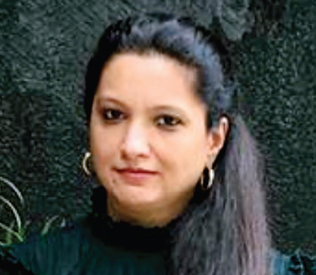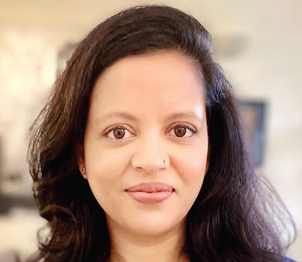Demystifying the Metaverse

The metaverse-this immersive technology and virtual world, is steadily becoming the reality. And within no time, it will become our way of life. At the recently concluded 7th Edition of WomeNation Summit, with the theme #BreakTheBias, the panellists spoke on the hottest topic - the metaverse. The session highlights that as the metaverse is becoming the talk of the town, we need to ensure that the biases we carry in the physical world are not carried over to the virtual world. And, looks into how are companies who are investing in the metaverse doing that. The session was moderated by Ninad Karpe, Partner, 100X.VC and the panellist included - Bhavika Chouhan, Sr. Vice President, Aptech; Amrita Thapar, Chief Marketing Officer, Microsoft India and Sophiya Jagannathan, Co-Founder, Metashop. Corporate Citizen brings you excerpts from the session.
Ninad Karpe: From the real world to the metaverse, there cannot be a better time or a better panel comprising of co-founders of very young start-ups to stalwarts. Incidentally, in the metaverse, everything is very precise yet with a deep meaning. The word metaverse is everywhere and people love it. Let’s hear everyone’s thoughts on how this technology will affect our work and life.
 Ninad Karpe
Ninad Karpe
Amrita Thapar: From my learning and understanding of metaverse, it has also increased significantly since I’ve come on board with Microsoft. It’s basically bridging the digital and physical worlds. And as you think about it, we are already doing it. A decade ago, people would travel physically to attend such an event. Now we are doing it virtually. Metaverse is basically the next league of the same concept, that you can do things without physically being there. This is also a bridge between the past and the future, which has everything in 2D. I’m talking to you on a screen, but if you were doing this on a metaverse, we’d use the same rules and principles and will be using technology to assist us in how we interact. To me, if you think about the fact about learning or interacting or virtual onboarding, all these things will only get easier and more immersive. Things that you may decline today because we think it’s too static, just like listening to a music concert live, you think you want to hear the recording but if you could do that in the metaverse, you’d say yes. I think there are many use cases which we will be readily embraced. The myth that people have are highly exaggerated, which comes from a lack of understanding of the fact that it’s another dimension to what we are using today. And talking about my emotion towards metaverse, I’m very excited about it.
"I’ve been associated with the education industry since long, if you ask me from IT training to animation and other verticals of tech, the ratio used to be 80:20 male to female, now I see this has increased somewhere between 35-40 per cent"
-Bhavika Chouhan,
 Bhavika Chouhan
Bhavika Chouhan
So, my next question is to Bhavika. How are women today shaping the metaverse?
Bhavika Chouhan: There are women here who work at different positions and are also dealing with metaverse every day. A lot has been spoken about it, and about inclusion, diversification or having women on different platforms is an important aspect. When we talk about the metaverse, the initial picture that comes forth is of gaming, which is generally associated with men more than females. We are into training and education-there sure is a shift in this perception. We have Sophiya on the panel who is creating 3D outlets, the same set is being created at our institution. We do have content creators for this particular segment. There is a lot of change and inclusion both in teaching and teacher aspects as well. I do see a lot of girls today adapting to this and wanting to explore.
Would you say compared to the animation industry, metaverse has welcomed diversity more?
Bhavika Chouhan: It has! I’ve been associated with the education industry since long. If you ask me from IT training to animation and other verticals of tech, the ratio used to be 80:20 male to female, now I see this has increased somewhere between 35-40 per cent. Today my audience is female students. They are looking at programming that has hardcore gaming, design, art, creation, and other aspects. And this gives a lot of hope. We interact with a lot of industries that are into the creative side. And today we have female experts, who are from this industry too. I heard someone saying there are very few role models in this industry for girls to join in. But look at the bright side, there are role models. It’s not that they are not there. In our segment, there are a lot of limitations. The working hours and other things, that does limit the number of women in the field. But with the pandemic things have changed a lot. Work from home is the new normal. Everybody is very open to allowing this kind of diversity. It’s been taken up and welcomed by all. Looking at the other end there are parents, who are now open to the idea of the girl child taking up this career-an option that suits her where her passion lies.
"Metaverse provides a clean canvas for women who are looking to make it big or trying to shift their domain. And this canvas comes with no pre-set rules or mindsets. So, everyone can make their mark. It’s now or never for women to embrace these chances."
-Sophiya Jagannathan,
Good to hear such kind of transformation. My question to you (Sophiya) is, does metaverse offer a different narrative for women in tech?
 Sophiya Jagannathan
Sophiya Jagannathan
Sophiya Jagannathan: To begin with, only 19 per cent of women work in tech. With an even lower percentage when it comes to women of colour. This lack of representation lists to issues like AI tools, search engines, facial recognition, e-commerce and chatbots. With a general lack of visible female role models and lingering stereotypes around women in tech. Unfortunately, in their early stage of life, they are made to feel that they don’t belong here. Coming to the question, will metaverse offer a different narrative? I think it totally will, because there are a plethora of chances for women to make an impact. Metaverse provides a clean canvas for women who are looking to make it big or trying to shift their domain. And this canvas comes with no pre-set rules or mindsets. So, everyone can make their mark. There’s a strong chance to create a better society if designing companies that are working on metaverse gaming and fashion industries, have inclusivness in mind. Giving all an equal chance. Also, I think women who are ready to engage themselves in the global community that is constructing the metaverse, have access to a whole new parallel economy. So, it’s now or never for women to embrace these chances.
"If we can use and embrace the metaverse without feeling threatened, and without having unpleasant experiences, then we are only going to attract more people. It is up to society and big tech companies to make it safe and loved by all."
-Amrita Thapar,
That’s quite passionate. This looks like a new chapter and opportunity. You (Amrita) work in a large tech company. How do large tech companies support equality in the metaverse?
 Amrita Thapar
Amrita Thapar
Amrita Thapar: Big technology companies have a huge responsibility, as well as we all have seen especially in the last decade with the rise of big tech and its all pervasiveness. So, when it comes to the metaverse, the responsibility doesn’t go away. It’s the same set of ethical principles, rules and code of conduct that are applied to the metaverse. So, they have a responsibility to architect it in a way that makes people trust this technology. Architect the system in a way that it becomes intrusive and accessible to all. And, it basically should be people-centric. If you focus on trust and ethical code of conduct, intrusiveness, and accessibility it will provide a splendid user experience. If we can use and embrace the metaverse without feeling threatened, and without having unpleasant experiences, then we are only going to attract more people. It is up to society and big tech companies to make it safe and loved by all.
Will the adoption rate amongst women improve dramatically?
Amrita Thapar: We will have to wait and watch. To be honest. I come from the segment which is more into content creation. Also, if you see the user experience, today most of the shoppers are women. Data says 80-85 percent are women. If that is the case, I see a lot of them adapting it. As it’s said metaverse is a blank canvas and if it creates a safe environment it will surely be embraced by all.
How can someone ensure a safe and equal environment in the metaverse?
Sophiya Jagannathan: By using customisable avatars the issue of gender equality can be eliminated from the identity of the user. In the metaverse, it is based completely on the avatar that has selected characteristics. Through this approach, traits of gender and race becomes irrelevant as users can create fictional characters of themselves. They just have to develop their profile; they can choose their characteristics’ and are ranked as per their merits and the interactions the avatars have between themselves, are outright advantages. This creates a field for individuals in the metaverse, regardless of real-world characteristics. Just would like to add one point, some Asian counties still don’t have their avatars, they must pick something that resembles them. With that, women are twice likely to face cybersickness. I have faced that too. The rear headset doesn’t fit my head and there is an issue while selecting the avatar. Coming to safety measures, systems should be implemented that tracks the behaviour of avatars and physical harassment prevention system should stop the culprits before any event occurs. These two systems can easily stop virtual harassment. To ensure safety, social media protocols must be implemented that detect user behaviour. And if any action needs to be taken, it should be taken immediately. Companies who are implementing metaverse should have strict safety policies.